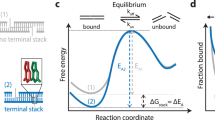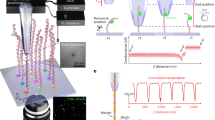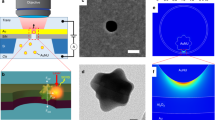Abstract
This protocol describes the procedures for measuring nanometer distances in nucleic acids using a nitroxide probe that can be attached to any nucleotide within a given sequence. Two nitroxides are attached to phosphorothioates that are chemically substituted at specific sites of DNA or RNA. Inter-nitroxide distances are measured using a four-pulse double electron–electron resonance technique, and the measured distances are correlated to the parent structures using a Web-accessible computer program. Four to five days are needed for sample labeling, purification and distance measurement. The procedures described herein provide a method for probing global structures and studying conformational changes of nucleic acids and protein/nucleic acid complexes.
This is a preview of subscription content, access via your institution
Access options
Subscribe to this journal
Receive 12 print issues and online access
$259.00 per year
only $21.58 per issue
Buy this article
- Purchase on Springer Link
- Instant access to full article PDF
Prices may be subject to local taxes which are calculated during checkout




Similar content being viewed by others
References
Fanucci, G.E. & Cafiso, D.S. Recent advances and applications of site-directed spin labeling. Curr. Opin. Struct. Biol. 16, 644–653 (2006).
Qin, P.Z. & Dieckmann, T. Application of NMR and EPR methods to the study of RNA. Curr. Opin. Struct. Biol. 14, 350–359 (2004).
Hubbell, W.L. & Altenbach, C. Investigation of structure and dynamics in membrane proteins using site-directed spin labeling. Curr. Opin. Struct. Biol. 4, 566–573 (1994).
Hubbell, W.L., Cafiso, D.S. & Altenbach, C. Identifying conformational changes with site-directed spin labeling. Nat. Struct. Biol. 7, 735–739 (2000).
Berliner, L.J., Eaton, G.R. & Eaton, S.S. (eds.) Distance measurements in biological systems by EPR. In: Biological Magnetic Resonance 19, 614 (Kluwer Academic, New York, 2000).
Borbat, P.P., Costa-Filho, A.J., Earle, K.A., Moscicki, J.K. & Freed, J.H. Electron spin resonance in studies of membranes and proteins. Science 291, 266–269 (2001).
Lakshmi, K.V. & Brudvig, G.W. Pulsed electron paramagnetic resonance methods for macromolecular structure determination. Curr. Opin. Struct. Biol. 11, 523–531 (2001).
Hubbell, W.L., Altenbach, C., Hubbell, C.M. & Khorana, H.G. Rhodopsin structure, dynamics, and activation: a perspective from crystallography, site-directed spin labeling, sulfhydryl reactivity, and disulfide cross-linking. Adv. Protein. Chem. 63, 243–290 (2003).
Steinhoff, H.J. Inter- and intra-molecular distances determined by EPR spectroscopy and site-directed spin labeling reveal protein-protein and protein-oligonucleotide interaction. Biol. Chem. 385, 913–920 (2004).
Jeschke, G. EPR techniques for studying radical enzymes. Biochim. Biophys. Acta. 1707, 91–102 (2005).
Jeschke, G. & Polyhach, Y. Distance measurements on spin-labelled biomacromolecules by pulsed electron paramagnetic resonance. Phys. Chem. Chem. Phys. 9, 1895–1910 (2007).
Schiemann, O. et al. Spin labeling of oligonucleotides with the nitroxide TPA and use of PELDOR, a pulse EPR method, to measure intramolecular distances. Nat. Protoc. 2, 904–923 (2007).
Rabenstein, M.D. & Shin, Y.K. Determination of the distance between two spin labels attached to a macromolecule. Proc. Natl. Acad. Sci. USA 92, 8239–8243 (1995).
Altenbach, C., Oh, K.J., Trabanino, R.J., Hideg, K. & Hubbell, W.L. Estimation of inter-residue distances in spin labeled proteins at physiological temperatures: experimental strategies and practical limitations. Biochemistry, 40, 15471–15482 (2001).
Kim, N., Murali, A. & DeRose, V.J. A distance ruler for RNA using EPR and site-directed spin labeling. Chem. Biol. 11, 939–948 (2004).
Persson, M. et al. Comparison of electron paramagnetic resonance methods to determine distances between spin labels on human carbonic anhydrase II. Biophys. J. 80, 2886–2897 (2001).
Borbat, P.P., McHaourab, H.S. & Freed, J.H. Protein structure determination using long-distance constraints from double-quantum coherence ESR: study of T4 lysozyme. J. Am. Chem. Soc. 124, 5304–5314 (2002).
Schiemann, O., Weber, A., Edwards, T.E., Prisner, T.F. & Sigurdsson, S.T. Nanometer distance measurements on RNA using PELDOR. J. Am. Chem. Soc. 125, 3334–3335 (2003).
Schiemann, O. et al. A PELDOR based nanometer distance ruler for oligonucleotides. J. Am. Chem. Soc. 126, 5722–5729 (2004).
Borbat, P.P., Davis, J.H., Butcher, S.E. & Freed, J.H. Measurement of large distances in biomolecules using double-quantum filtered refocused electron spin-echoes. J. Am. Chem. Soc. 126, 7746–7747 (2004).
Sale, K., Song, L., Liu, Y.S., Perozo, E. & Fajer, P. Explicit treatment of spin labels in modeling of distance constraints from dipolar EPR and DEER. J. Am. Chem. Soc. 127, 9334–9335 (2005).
Banham, J.E., Timmel, C.R., Abbott, R.J., Lea, S.M. & Jeschke, G. The characterization of weak protein-protein interactions: evidence from DEER for the trimerization of a von Willebrand Factor A domain in solution. Angew. Chem. Int. Ed. Engl. 45, 1058–1061 (2006).
Cai, Q. et al. Site-directed spin labeling measurements of nanometer distances in nucleic acids using a sequence-independent nitroxide probe. Nucleic Acids Res. 34, 4722–4734 (2006).
Piton, N. et al. Base-specific spin-labeling of RNA for structure determination. Nucleic Acids Res. 35, 3128–3143 (2007).
Cai, Q. et al. Nanometer distance measurements in RNA using site-directed spin labeling. Biophys. J. 93, 2110–2117 (2007).
Makinen, M.W., Mustafi, D. & Kasa, S. ENDOR of spin labels for structure determination: from small molecules to enzyme reaction intermediates. in Biological Magnetic Resonance (ed. Berliner, L.J.) 181–249 (Springer-Verlag, New York, LLC 1998).
Qin, P.Z., Butcher, S.E., Feigon, J. & Hubbell, W.L. Quantitative analysis of the isolated GAAA tetraloop/receptor interaction in solution: a site-directed spin labeling study. Biochemistry 40, 6929–6936 (2001).
Pannier, M., Veit, S., Godt, A., Jeschke, G. & Spiess, H.W. Dead-time free measurement of dipole-dipole interactions between electron spins. J. Magn. Reson. 142, 331–340 (2000).
Price, E.A., Sutch, B.T., Cai, Q., Qin, P.Z. & Haworth, I.S. Computation of nitroxide-nitroxide distances for spin-labeled DNA duplexes. Biopolymers 87, 40–50 (2007).
Spaltenstein, A., Robinson, B.H. & Hopkins, P.B. Sequence- and structure- dependent DNA base dynamics: synthesis, structure, and dynamics of site and sequence specifically spin-labeled DNA. Biochemistry 28, 9484–9495 (1989).
Edwards, T.E., Okonogi, T.M., Robinson, B.H. & Sigurdsson, S.T. Site-specific incorporation of nitroxide spin-labels into internal sites of the TAR RNA; structure-dependent dynamics of RNA by EPR spectroscopy. J. Am. Chem. Soc. 123, 1527–1528 (2001).
Qin, P.Z., Hideg, K., Feigon, J. & Hubbell, W.L. Monitoring RNA base structure and dynamics using site-directed spin labeling. Biochemistry 42, 6772–6783 (2003).
Gannett, P.M. et al. Probing triplex formation by EPR spectroscopy using a newly synthesized spin label for oligonucleotides. Nucleic Acids Res. 30, 5328–5337 (2002).
Barhate, N., Cekan, P., Massey, A.P. & Sigurdsson, S.T. A nucleoside that contains a rigid nitroxide spin label: a fluorophore in disguise. Angew. Chem. Int. Ed. Engl. 46, 2655–2658 (2007).
Milov, A.D., Salikohov, K.M. & Shirov, M.D. Applications of ENDOR in electron-spin echo for paramagnetic center space distribution in solids. Fiz. Tverd. Tela,. 23, 975–982 (1981).
Kurshev, V.V., Raitsimring, A.M. & Tsvetkov, Y.D. Selection of dipolar interaction by the “2 + 1” pulse train ESE. J. Magn. Reson. 81, 441–454 (1989).
Milov, A.D., Ponomarev, A.B. & Tsvetkov, Y.D. Electron-electron double resonance in electron spin echo: model biradical systems and the sensitized photolysis of decalin. Chem. Phys. Lett. 110, 67–72 (1984).
Larsen, R.G. & Singel, D.J. Double electron—electron resonance spin—echo modulation: Spectroscopic measurement of electron spin pair separations in orientationally disordered solids. J. Chem. Phys. 98, 5134–5146 (1993).
Rakowsky, M.H., More, K.M., Kulikov, A.V., Eaton, G.R. & Eaton, S.S. Time-domain electron paramagnetic resonance as a probe of electron-electron spin-spin interaction in spin-labeled low-spin iron porphyrins. J. Am. Chem. Soc. 117, 2049–2057 (1995).
Saxena, S. & Freed, J.H. Double quantum two-dimensional Fourier transform electron spin resonance: distance measurements. Chem. Phys. Lett. 251, 102–110 (1996).
Martin, R.E. et al. Determination of end-to-end distances in a series of TEMPO diradicals of up to 2.8 nm length with a new four-pulse double electron electron resonance experiment. Angew. Chem. Int. Ed. Engl. 37, 2833–2837 (1998).
Hinderberger, D., Schmelz, O., Rehahn, M. & Jeschke, G. Electrostatic site attachment of divalent counterions to rodlike ruthenium(II) coordination polymers characterized by EPR spectroscopy. Angew. Chem. Int. Ed. Engl. 43, 4616–4621 (2004).
Pornsuwan, S., Bird, G., Schafmeister, C.E. & Saxena, S. Flexibility and lengths of bis-peptide nanostructures by electron spin resonance. J. Am. Chem. Soc. 128, 3876–3877 (2006).
Jeschke, G., Wegener, C., Nietschke, M., Jung, H. & Steinhoff, H.J. Interresidual distance determination by four-pulse double electron-electron resonance in an integral membrane protein: the Na+/proline transporter PutP of Escherichia coli. Biophys. J. 86, 2551–2557 (2004).
Hanson, S.M. et al. Structure and function of the visual arrestin oligomer. EMBO J. 26, 1726–1736 (2007).
Oldham, W.M., Van Eps, N., Preininger, A.M., Hubbell, W.L. & Hamm, H.E. Mechanism of the receptor-catalyzed activation of heterotrimeric G proteins. Nat. Struct. Mol. Biol. 13, 756–757 (2006).
Leporc, S. et al. An NMR and molecular modeling analysis of d(CTACTGCTTTAG). d(CTAAAGCAGTAG) reveals that the particular behavior of TpA steps is related to edge-to-edge contacts of their base-pairs in the major groove. Nucleic Acids Res. 27, 4759–4767 (1999).
Caruthers, M.H., Beaton, G., Wu, J.V. & Wiesler, W. Chemical synthesis of deoxyoligonucleotides and deoxyoligonucleotide analogs. in: Methods in Enzymology (eds. Lilley, D.M.J. and Dahlberg, J.E.) 3–20 (Elsevier, 1992).
Usman, N. & Cedergren, R. Exploiting the chemical synthesis of RNA. Trends Biochem. Sci. 17, 334–339 (1992).
Iyer, R.P., Phillips, L.R., Egan, W., Regan, J.B. & Beaucage, S.L. The automated synthesis of sulfur-containing oligodeoxyribonucleotides using 3H-1,2-benzodithiol-3-one 1,1-dioxide as a sulfur-transfer reagent. J. Org. Chem. 55, 4693–4699 (1990).
Hankovszky, H.O., Hideg, K. & Lex, L. Nitroxyls; VII1. Synthesis and reactions of highly reactive 1-Oxyl-2,2,5,5-tetramethyl-2,5-dihydropyrrole-3-ylmethyl sulfonates. Synthesis 914–916 (1980).
Lindgren, M. et al. Electron spin echo decay as a probe of aminoxyl environment in spin-labeled mutants of human carbonic anhydrase II. J. Chem. Soc. Perkin Trans. 2, 2549–2554 (1997).
Zecevic, A., Eaton, G.R., Eaton, S.S. & Lindgren, M. Dephasing of electron spin echoes for nitroxyl radicals in glassy solvents by non-methyl and methyl protons. Mol. Phys. 95, 1255–1263 (1998).
Weber, R.T. Bruker ELEXSYS E580 User's Manual (v. 2.0) 2005.
Weber, R.T. Bruker Pulsed ELDOR Option User's Manual (v. 1.0) 2006.
Jeschke, G., Panek, G., Godt, A., Bender, A. & Paulsen, H. Data analysis procedures for pulse ELDOR measurements of broad distance distributions. Appl. Magn. Reson. 26, 223–244 (2004).
Bowman, M.K., Maryasov, A.G., Kim, N. & DeRose, V.J. Visulation of distance distribution from pulsed double electron-electron resonance data. Appl. Magn. Reson. 26, 23–39 (2004).
Chiang, Y.W., Borbat, P.P. & Freed, J.H. The determination of pair distance distributions by pulsed ESR using Tikhonov regularization. J. Magn. Reson. 172, 279–295 (2005).
Berman, H.M. et al. The Protein Data Bank. Nucleic Acids Res. 28, 235–242 (2000).
Berman, H.M. et al. The nucleic acid database. A comprehensive relational database of three-dimensional structures of nucleic acids. Biophys. J. 63, 751–759 (1992).
Case, D.A. et al. AMBER8 Users' Manual (University of California, San Francisco, California, 2004).
Acknowledgements
We thank Dr. Wayne L. Hubbell for providing access to a Bruker E-580 spectrometer; Drs. Wayne L. Hubbell, Christian Altenbach, Ned Van Eps and Balachandra G. Hegde for advice and discussions on DEER measurements; and Drs. Eric Chambers and Melina Bayramyan for early development of the NASDAC algorithm framework in which the NASNOX algorithm is based. Financial support is provided by the National Institutes of Health (R01 GM069557) and the National Science Foundation (MCB0546529). The authors also thank the William R. Wiley Environmental Molecular Sciences Laboratory for a pulse EPR instrumentation time award.
Author information
Authors and Affiliations
Corresponding author
Rights and permissions
About this article
Cite this article
Qin, P., Haworth, I., Cai, Q. et al. Measuring nanometer distances in nucleic acids using a sequence-independent nitroxide probe. Nat Protoc 2, 2354–2365 (2007). https://doi.org/10.1038/nprot.2007.308
Published:
Issue Date:
DOI: https://doi.org/10.1038/nprot.2007.308
This article is cited by
-
Single-DNA electron spin resonance spectroscopy in aqueous solutions
Nature Methods (2018)
-
Nucleic Acid-Dependent Conformational Changes in CRISPR–Cas9 Revealed by Site-Directed Spin Labeling
Cell Biochemistry and Biophysics (2017)
-
High-Frequency Electron Paramagnetic Resonance Spectroscopy of Nitroxide-Functionalized Nanodiamonds in Aqueous Solution
Cell Biochemistry and Biophysics (2017)
-
A nucleotide-independent cyclic nitroxide label for monitoring segmental motions in nucleic acids
BMC Biophysics (2015)
-
EPR-aided approach for solution structure determination of large RNAs or protein–RNA complexes
Nature Communications (2014)
Comments
By submitting a comment you agree to abide by our Terms and Community Guidelines. If you find something abusive or that does not comply with our terms or guidelines please flag it as inappropriate.



